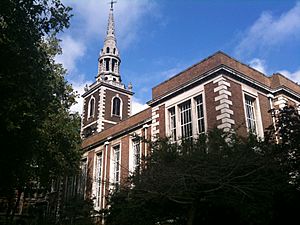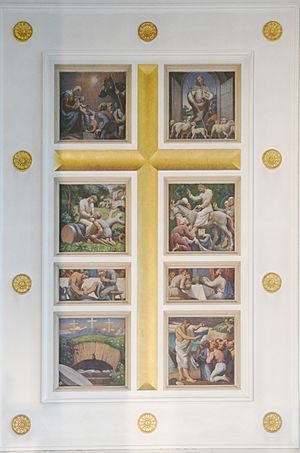St Mary's Church, Islington facts for kids
Quick facts for kids St Mary's Church, Islington |
|
|---|---|
| The Parish Church of St Mary, Islington | |

St Mary's Church viewed from the church gardens
|
|
| Location | Upper Street, Islington, London |
| Country | England |
| Denomination | Church of England |
| Churchmanship | Open Evangelical |
| History | |
| Founded | 12th Century (estimate) |
| Dedication | Mary the Virgin |
| Architecture | |
| Functional status | Active |
| Heritage designation | Grade II listed |
| Architect(s) | Lancelot Dowbiggin, Reginald Blomfield, Seely & Paget |
| Administration | |
| Parish | Islington, St Mary |
| Deanery | Islington |
| Archdeaconry | Hackney |
| Episcopal area | Stepney |
| Diocese | London |
| Province | Canterbury |
The Church of St Mary the Virgin is a very old and important church in Islington, London. It's part of the Church of England. This church is a special Grade II listed building, which means it's protected because of its history and architecture.
The church is located on Upper Street in Islington. Its churchyard, which is the area around the church, was made bigger in 1793. By 1853, it was full and no longer used for burials. In 1885, it was turned into a public garden for everyone to enjoy.
History of St Mary's Church
Early Beginnings: Before the 17th Century
The first church building here was built way back in the 1100s. It was later replaced by a new one in the 1400s.
One of the early vicars, John Farley, was mentioned in records from 1446. Before he became a bishop in 1509, Edward Vaughan also served as a vicar here. Robert Browne, who helped start the Congregational churches, was a lecturer at St Mary's until about 1578.
The 17th Century: New Faces and Events
In 1606, John Webster, a famous writer of plays, got married at St Mary's. William Cave became the vicar in 1662 when he was only 25 years old. He stayed in that role until 1689 and was later buried at the church.
The 18th Century: Charles Wesley and Rebuilding
In 1738, the vicar of St Mary's, George Stonehouse, invited Charles Wesley to help lead the church services. Charles Wesley was a very famous preacher and hymn writer. He preached many times at St Mary's.
However, some people didn't like Wesley's preaching. In 1739, he and George Whitefield were asked to leave the church. After this, Wesley joined his brother John in preaching outdoors.
The church building itself became very old and damaged. So, in 1750, a special law was passed to allow it to be rebuilt. The new church, designed by Lancelot Dowbiggin, was finished and opened in 1754.
During this time, the church also started to connect with leaders from Africa. In 1759, Philip Quaque, whose father was a king in Ghana, was baptized at St Mary's. He later became the first black African to become a priest in the Church of England. He then returned to Ghana to work as a missionary.
The 19th Century: Growth and Important Figures
Daniel Wilson was the vicar from 1824 to 1832. He later became a bishop in India. He also helped start the Lord's Day Observance Society in 1831. The Islington Clerical Conference, a meeting for church leaders, was started by Daniel Wilson and held at St Mary's for many years. His son, also named Daniel, was vicar for 54 years. During his time, many new churches were created in Islington because the population grew so much.
A young boy named Samuel Ajayi Crowther came to Islington from Sierra Leone in 1826. He studied at the church's school and attended services. He later became a minister and the first African Bishop in Nigeria. He was also a great linguist, creating a grammar for the Yoruba language and translating the Book of Common Prayer into Yoruba. He returned to Islington several times, and in 1870, he ordained his own son, Dandeson Crowther, at St Mary's Church.
William Hagger Barlow became vicar after Daniel Wilson the second. He built the Bishop Wilson Memorial Hall and the vicarage, which is where the vicar lives.
The 20th Century: War and Rebuilding
In 1904, a large entrance porch made of Portland stone was added to the church. It was designed by Sir Reginald Blomfield and includes a carving of the Nativity (the birth of Jesus).
Several important church leaders served at St Mary's. Donald Coggan, who later became the Archbishop of Canterbury, was a curate (an assistant minister) from 1934 to 1937. David Sheppard, who later became the Bishop of Liverpool, played cricket for England while he was an assistant curate at Islington from 1955 to 1957.
During the London Blitz in World War II, on September 9, 1940, a bomb hit the church. Most of the church was destroyed, but the tower and spire remained standing.
The church was rebuilt after the war. The new building was dedicated in 1956. The architects, John Seely and Paul Paget, designed a large and bright space. The main worship area is very big and has large, clear windows that let in a lot of natural light. The east and west ends of the church have beautiful murals painted by Brian Thomas. Some parts of the original church, like the lectern (where readings are given), the baptismal font, and the Royal Arms, survived the bombing and are still used today.
In 1962, George Carey became a curate. He worked with local council groups and started a new Boys' Club. In 1967, the first Asian Christian Church in the UK started at St Mary's Church, holding services in Urdu.
The 21st Century: Continuing Community Work
In 2003, the vicar Graham Kings helped start a group called Fulcrum. This group works to keep the evangelical tradition strong within the Church of England.
As Islington became a more popular place to live, St Mary's Church continued to help the people in the area. The crypt, which is the space under the church, was completely changed and improved to serve the community.
Worship Services at St Mary's
St Mary's Church holds worship services almost every day of the week. On Sundays, the main service is at 11:00 AM. Once a month, on the third Sunday, there is a special Taize-style service at 6:00 PM, which is a quiet and reflective service with simple songs. The traditional Book of Common Prayer is used for a Holy Communion service once a month at 9:00 AM.
On weekdays, a morning prayer meeting takes place at 9:30 AM.
External Links
- A Church Near You website with map of parish


